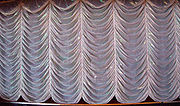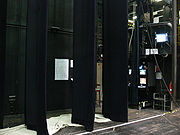
Theater drapes and stage curtains
Encyclopedia

Velour
Velour or velours is a plush, knitted fabric or textile. It is usually made from cotton but can also be made from synthetic materials such as polyester. Velour is used in a wide variety of applications, including clothing and upholstery....
.
Proscenium
Proscenium
A proscenium theatre is a theatre space whose primary feature is a large frame or arch , which is located at or near the front of the stage...
stages use a greater variety of drapes than arena
Theatre in the round
Theatre-in-the-round or arena theatre is any theatre space in which the audience surrounds the stage area...
or thrust stage
Thrust stage
In theatre, a thrust stage is one that extends into the audience on three sides and is connected to the backstage area by its up stage end. A thrust has the benefit of greater intimacy between performers and the audience than a proscenium, while retaining the utility of a backstage area...
s. In proscenium theaters, drapes are typically suspended from batten
Batten (theater)
In theater, batten refers to a long metal pole suspended above the stage or the audience from which lighting fixtures, theatrical scenery, tabs or other curtains may be hung...
s that are controlled by a fly system
Fly system
A fly system, flying system or theatrical rigging system, is a system of lines , blocks , counterweights and related devices within a theatre that enable a stage crew to quickly, quietly and safely fly components such as curtains, lights, scenery, stage effects and, sometimes, people...
(i.e., they are "flown", in theater terminology). When a drape is flown, the task of adjusting its height for best masking effect is simplified and, in the case of a drape that must be moved during a performance, this enables the drape to be quickly raised above the proscenium arch—thus positioning it out of view of spectators—or lowered to any arbitrary height above the stage, as required.
Grand drapes

Front curtain
The front curtain, also known as the house curtain, act curtain, grand drape, main drape or main rag is a stage curtain at the very front of a stage....
, which is variously called a grand drape, act curtain, house curtain, house drape, main drape or, in the UK, tabs, hangs upstage (i.e., toward the rear of the stage) of the proscenium arch. There are several common types of front curtains:
- In smaller theaters, they often consist of two curtains which part horizontally (known as a traveler).
- In larger theaters, they usually open vertically, disappearing out of sight into the fly tower. This style of opening is known as a guillotineGuillotineThe guillotine is a device used for carrying out :executions by decapitation. It consists of a tall upright frame from which an angled blade is suspended. This blade is raised with a rope and then allowed to drop, severing the head from the body...
reveal, after the famous execution tool. - A single curtain which covers the entire opening by moving horizontally is called a wipe.
- A tableau curtain gathers the two sections of fabric up and to the sides (in a "French Action") and usually forms a draped effect when it is opened.
- A Venetian or Braille curtain has vertical lift lines across the back which raise the curtain by gathering it up from the bottom.
- An Austrian curtain or a Roman Drape is similar to a Venetian curtain but instead of the fabric hanging straight down in pleats, the fabric hangs in swags between the lift lines.
- A contour or profile curtain is a Venetian or Austrian curtain in which the lift lines can be raised and lowered independently, allowing the curtain opening to be shaped.
False proscenium
Hard teasers and tormentors are flat, horizontal and vertical (respectively) pieces that are located just upstage of the grand drape. Together, one hard teaser and a pair of tormentors (one on each side of the stage) are frequently used to form a reduced-size "false proscenium" within the frame of the actual theater proscenium. Hard teasers and tormentors are typically covered with thin plywood, which in turn is covered with dark colored, light-absorbing material. The teaser is usually flown from a dedicated battenBatten (theater)
In theater, batten refers to a long metal pole suspended above the stage or the audience from which lighting fixtures, theatrical scenery, tabs or other curtains may be hung...
so that its height can be independently adjusted so as to optimize its masking of the flies (the fly system and its loads).
In some productions, a show portal is used in place of a false proscenium. This is a decorative "frame" for the stage which also serves to mask backstage areas, just as a teaser and tormentors would.
Legs, borders and tabs

Tabs are drapes that hang at the sides of the stage perpendicular to the proscenium opening to mask the wings, as shown in the drawing at the top of this page.
Scrims
A scrim, sometimes gauze, is a curtain made of an open-weave fabric that appears opaque when lit from the front, but transparent when a person or object behind the curtain is lit.Backdrops
A backdropTheatrical scenery
Theatrical scenery is that which is used as a setting for a theatrical production. Scenery may be just about anything, from a single chair to an elaborately re-created street, no matter how large or how small, whether or not the item was custom-made or is, in fact, the genuine item, appropriated...
(or cloth) is a painted curtain that hangs in the back of the stage to indicate scenery.
Cycloramas
A cycloramaCyclorama (theater)
A cyclorama is a large curtain or wall, often concave, positioned at the back of the stage area. It was popularized in the German theater of the 19th century and continues in common usage today in theaters throughout the world...
or cyc is a large white curtain, often concave, at the back of the stage that can be lit to represent the sky or other backgrounds.
See also
- Theater (structure)Theater (structure)A theater or theatre is a structure where theatrical works or plays are performed or other performances such as musical concerts may be produced. While a theater is not required for performance , a theater serves to define the performance and audience spaces...
- Safety curtainSafety curtainA safety curtain is a fire safety precaution used in large proscenium theatres. It is usually a heavy fibreglass or iron curtain located immediately behind the proscenium arch. Asbestos-based materials were originally used to manufacture the curtain, before the dangers of asbestos were discovered...

